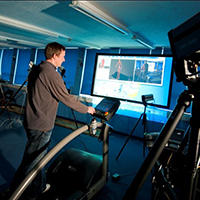A new framework for computational biomechanical models and 3Rs in musculoskeletal research
The University of Liverpool is collaborating with researchers at the University of Hull and University of Leeds to investigate the potential for computer models to realise replacement, reduction and refinement of animal use in musculoskeletal research. This four-year project is funded by the Biotechnology and Biological Sciences Research Council (UK).
This project has two overarching goals:
- To investigate the type and amount of experimental input data required for musculoskeletal computer models to deliver accurate predictions
- Provide quantitative data on the current and future potential of models to contribute to the reduction, replacement and refinement (3Rs) of animal experiments in scientific research.
To do this we will develop and validate new computational biomechanical models using mastication in rabbits as our case study. Rabbits have been chosen because they are widely used in a variety of research areas. They are the first-choice experimental animal for dental implant design and bone (re)growth studies because of their size, easy handling and relative similarities to humans in terms of bone composition, healing and anatomy. A digital model has the potential to completely replace (or maximally reduce) the use of animals in musculoskeletal research and/or medical device design.
The anatomy and behaviour of a digital model can be altered and re-tested without limitation and without any harm or distress to a real animal. This can also allow, for example: a model analysis to be extended to a different strain/breed of the same species (or a similar species) by digital modification of the anatomy/behaviour; elements of anatomy to be modified in multiple ways (e.g. removal of teeth/bone) to examine the consequences of different surgical approaches; and for implant devices to be digitally inserted into the models, and their impact on performance examined, all without the need for any harmful experimentation on real animals.
But improving biomechanical models will not only reduce animal use in research: it has the potential to improve modelling of human biomechanics. Currently models are used widely to study healthy biomechanics (e.g. sports performance), ageing (e.g. sacropenia) and related diseases (e.g. knee osteoarithitis), dental procedures (e.g. orthodontic treatment) and injury (e.g. hip fracture). In these human studies they are used to estimate or predict parameters that cannot be measured directly in people, thus their accuracy is inherently difficult to assess. Thus there is clear need for the type of study we propose here.
We hope that this research will generate the most comprehensive biomechanical models produced to-date by using an exhaustive and state-of-the-art experimental dataset. This will tell us how individual input parameters affect accuracy and help the musculoskeletal research community identify which parameters do not need to be measured through experimentation in real animals to achieve specific thresholds of accuracy.





